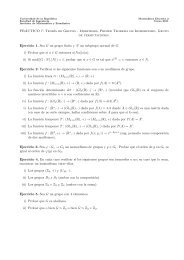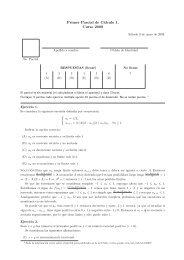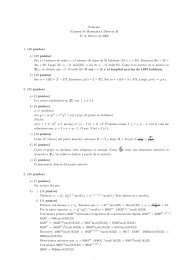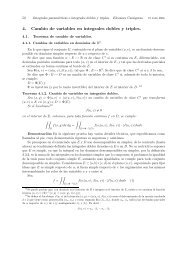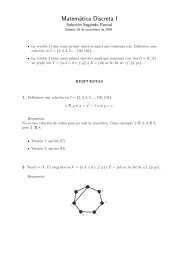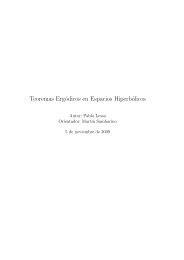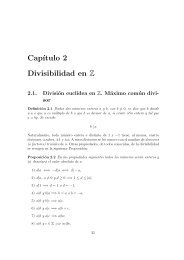Prácticos - IMERL
Prácticos - IMERL
Prácticos - IMERL
You also want an ePaper? Increase the reach of your titles
YUMPU automatically turns print PDFs into web optimized ePapers that Google loves.
TECNOLOGO MECANICO - MATEMATICA III<br />
(curso 2005)<br />
LISTA DE EJERCICIOS N o 1<br />
Integrales dobles<br />
1. Hallar los límites de integración, en un sentido y en el otro, para la integral doble <br />
D la siguiente región:<br />
(a) D es el rectángulo de vértices O = (0, 0), A = (2, 0), B = (2, 1), C = (0, 1)<br />
(b) D es el triángulo de vértices O = (0, 0), A = (1, 0), B = (1, 1)<br />
(c) D es el trapecio de vértices O = (0, 0), A = (2, 0), B = (1, 1), C = (0, 1)<br />
D<br />
f(x, y)dxdy siendo<br />
2. Dibujar la región de integración e invertir el orden de integración<br />
(a) <br />
2 <br />
0<br />
f(x, y)dy dx 1 −1 (b) <br />
1 <br />
1<br />
f(x, y)dy dx 0 x (c) <br />
2 2y<br />
0 y2 (e)<br />
<br />
f(x, y)dx dy<br />
<br />
3 <br />
2x<br />
f(x, y)dy dx 1 x (f) <br />
2 2−x<br />
−6 x2 <br />
−4 f(x, y)dy dx<br />
4<br />
(g) √ <br />
3−y<br />
f(x, y)dx dy<br />
<br />
1 √ <br />
x+1 √<br />
0<br />
x f(x, y)dy dx<br />
2<br />
(i) 1<br />
−1<br />
3. Calcular <br />
√<br />
3−y<br />
f(x, y)dx<br />
−y+1<br />
D<br />
f(x, y)dxdy .<br />
dy + 3<br />
1<br />
0<br />
(a) f : f(x, y) = x sin(y) − ye x y D = {(x, y) ∈ R 2 : −1 ≤ x ≤ 1, 0 ≤ y ≤ π<br />
2 }<br />
(b) f : f(x, y) = xy y D = {(x, y) ∈ R 2 : x ≤ 0, y 2 − 2y ≤ x}<br />
(c) f : f(x, y) = 2x + 3y y D = {(x, y) ∈ R 2 : y ≥ 0, y ≥ x, x − 2y + 1 ≥ 0}<br />
(d) f : f(x, y) = |x + y − 1| y D = {(x, y) ∈ R 2 : 0 ≤ x ≤ 1, 0 ≤ y ≤ 1}<br />
4. Calcular <br />
(a)<br />
(c)<br />
<br />
<br />
D<br />
PRACTICOS CURSO 2005<br />
MATEMATICA III<br />
f(x, y)dxdy utilizando un cambio de variable lineal.<br />
f : f(x, y) = cos(x − y) cos(x + 2y)<br />
D = {(x, y) ∈ R 2 : −2x ≤ y ≤ 0, x ≤ y + π}<br />
f : f(x, y) = (x − y) 2 sin 2 (x + y)<br />
D = {(x, y) ∈ R 2 : |x − π| + |y − π| ≤ π}<br />
1<br />
(b)<br />
(d)<br />
⎧<br />
⎪⎨<br />
⎪⎩<br />
⎧<br />
⎪⎨<br />
⎪⎩<br />
Página 1 de 23<br />
f : f(x, y) = (x − y)e x2 −y 2<br />
D es el cuadrado de vértices<br />
(2, 1), (0, 1), (1, 0), (1, 2)<br />
f : f(x, y) = e −(x+y)2<br />
D es el triángulo de vértices<br />
(0, 0), (0, 1), (1, 0)<br />
Mathías BOUREL - José DIAZ



